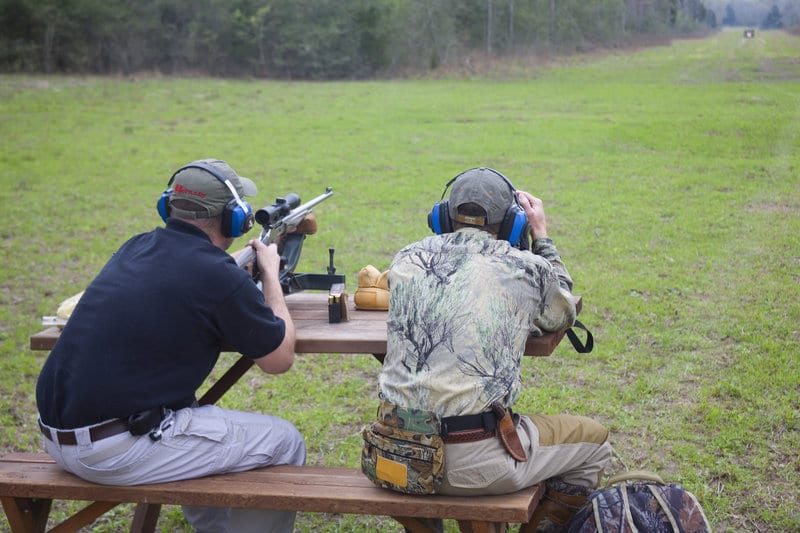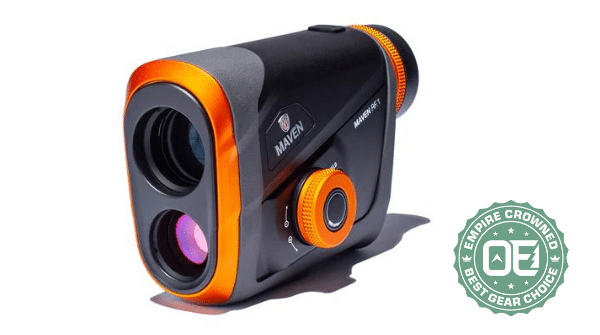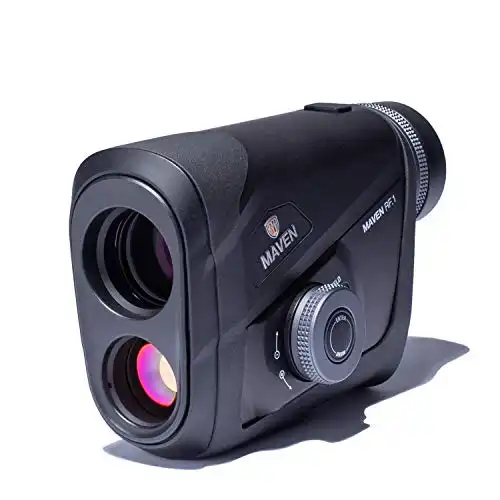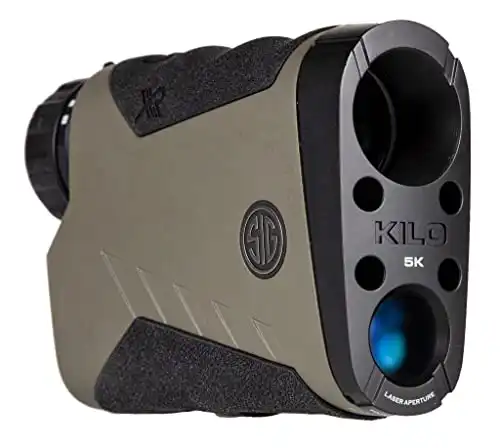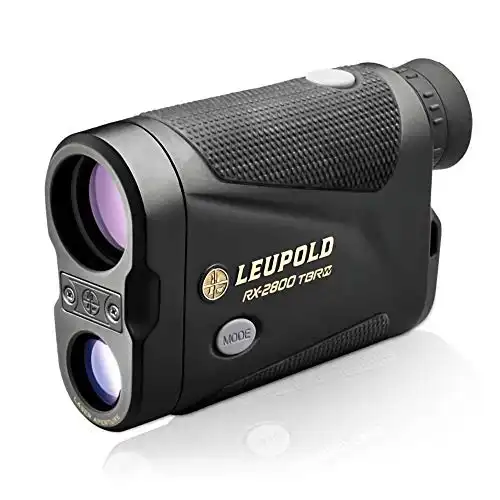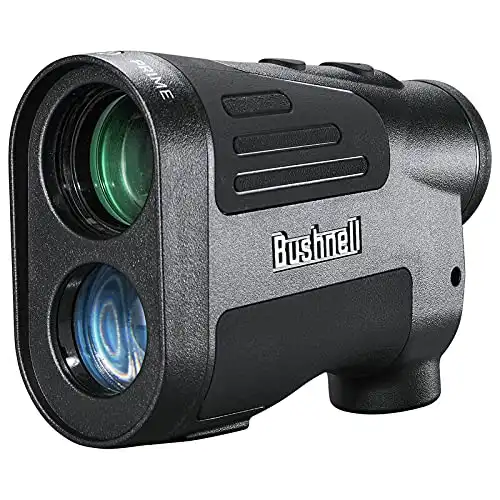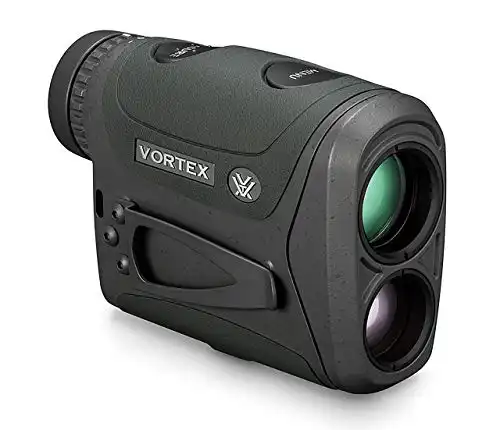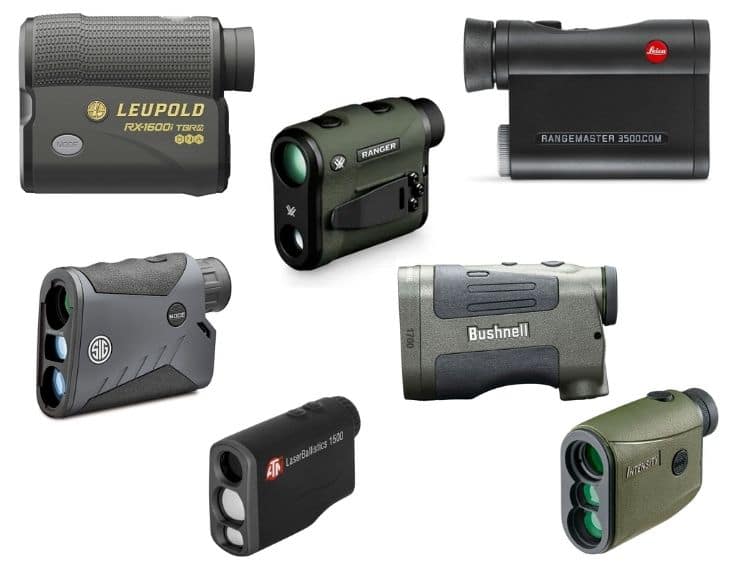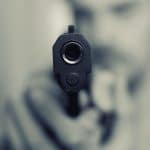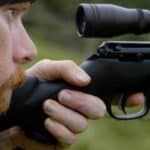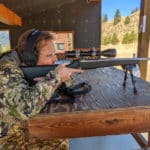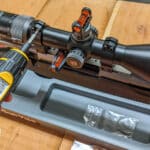Long-range shooting is an exact science. To be successful, the shooter must know and understand a long list of variables.
Of course, “long-range” is a subjective term, but for the purposes of this discussion, we will call it anything beyond 800 yards. Whether you are shooting those distances competitively, to harvest game, or just for fun, knowing the range of your shot is a critical component of executing it.
The best laser rangefinders for long range shooting are the Maven RF.1, the Sig Sauer KILO5K, and the Leupold RX-2800 TBR/W. Each of these provides quick, reliable, and accurate distances, even beyond 1500 yards in various light conditions. They also provide angle-compensated measurements.
However, they come at a considerable price compared to a typical golf or hunting rangefinder.
A quality rangefinder is an integral part of successful long-range shooting and the right one will become one of your most important tools. However, one that does not work correctly could totally prevent you from hitting your mark at long distances.
This article aims to help you know what to look for in a monocular rangefinder for long-range shooting. Based on our own hands-on experience and research, we’ll recommend the best rangefinders for long-range shooting that can help you advance your long-range shooting capabilities.
[This article was fully revised in May, 2022 by Chase Fly. The original article was authored by Travis Pike in 2018.]
DISCLOSURE: As an Amazon Associate I earn from qualifying purchases. Links in this article are affiliate links. If you click on a link we may earn a commission if you make a purchase, at no additional cost to you.
Best Rangefinders for Long Range Shooting in 2022: Outdoor Empire Reviews
These are our top recommendations for long-distance rangefinders in 2022:
- Best for the Money: Maven RF.1
- Upgrade Pick: Sig Sauer KILO5K
- Also Great: Leupold RX-2800 TBR/W
- Budget Pick: Bushnell Prime 1800
- Best of the Rest: Vortex Razor HD 4000
Looking for a specific feature? Check out our quick-reference chart below:
| Best for the Money | Upgrade Pick | Also Great | Budget Pick | Best of the Rest | |
|---|---|---|---|---|---|
| Product | 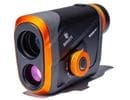 Maven RF.1 | 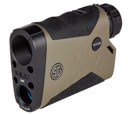 Sig Sauer KILO5K | 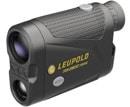 Leupold RX-2800 TBR/W | 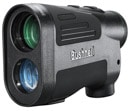 Bushnell Prime 1800 | 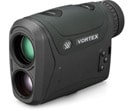 Vortex Razor HD 4000 |
| Outdoor Empire Score | 4.7 | 4.7 | 4.7 | 4.2 | 4.2 |
| Max Range to Trees | 3000 yds | 2500 yds | 2400 yds | 1000 yds | 2500 yds |
| Magnification | 7x | 7x | 7x | 6x | 7x |
| Objective Lens Diameter | 25mm | 25mm | 27mm | 24mm | 25mm |
| Weight | 10 oz | 7.5 oz | 7.9 oz | 6 oz | 9.9 oz |
| Warranty | Unconditional Lifetime | Unlimited on optics, 5 years on electronics | 2 years | 5 years | Unconditional Lifetime |
| Benefits | - Intuitive and easy to use - Premium optics and laser - IP67 rugged | - Packed with high-tech features - Compact and ergonomic | - Excellent glass - Fast and accurate - Built-in ballistics functions | - Cool display that changes from red to black - Features on par with more expensive units | - Proven brand, product, and warranty - Ergonomic and rugged - Reliable |
| Drawbacks | - No advanced ballistics calculations | - Lacks tripod mount | - Weak sauce warranty | - Limited range and accuracy - Optics just ok | - Slow to acquire a distance - No ballistics functionality |
| Cost | Check Price | Check Price | Check Price | Check Price | Check Price |
1. Best Long Range Rangefinder for the Money
- Outdoor Empire Score: 4.7
- MSRP: $450.00
- Bottom line: Premium glass, laser sensor, and warranty at a mid-range price
Though not an optics giant, Maven is an up-and-coming premium optics manufacturer that is run like a small direct-to-consumer business.
We’ve been using the Maven RF.1 for a while now, and not just in testing. We’ve taken it to the gun range as well as out scouting and hunting for wild Idaho mountain turkeys.
What We Like
The RF.1 has a commercial-grade laser sensor on board from a company out of Colorado called Laser Technology, Inc. This company primarily makes rangefinders for the professional measurement, land surveying, and law enforcement industries where long-range and accuracy are essential.
Though the distance rating to trees on the RF.1 is 3000 yds, we were able to range non-reflective hillsides at over 3200 yds. The tripod mount helps a lot for long-range. For closer objects, it gives readings fast and the accuracy checks out.
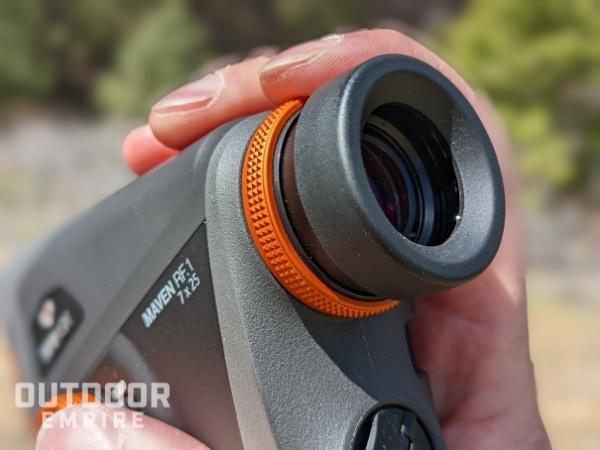
This is the easiest rangefinder to use among any we looked at. Besides a menu and a fire button like everyone else, it also has a menu dial and a simple switch to change your target priority. This intuitive setup means less clicking and waiting to adjust settings. We found this super handy, especially being able to just turn the dial to adjust brightness or flip the switch to go between Forest (last) and Field mode on-the-fly.
Lastly, Maven’s unlimited lifetime warranty cannot be beaten. Outside of theft or loss, they will fix or replace your RF.1 no matter what.
Recommended: Detailed Maven RF.1 Rangefinder Hands-on Review
What We Don’t Like
Unlike most other brands, you can’t touch and feel a Maven in the store before you buy it. But they will send one to you to actually try out before you commit to purchasing.
The RF.1 is also one of the bulkiest rangefinders in its class. But the upside here is that it’s super rugged, even IP67 rated which none of the others can claim.
Finally, this unit doesn’t have any fancy ballistics features. It does give you either Line of Sight (with an angle of elevation) or angle-compensated measurements, but no in-display holdover and windage, or app connectivity.
By our assessment, this rangefinder offers the best bang for your buck. The price, though not cheap, is the same as what you’d pay for lesser products elsewhere.
2. Upgrade Pick
- Outdoor Empire Score: 4.7
- MSRP: $718.99
- Bottom line: Packed full of tech for long-range precision rifle shooting
Compare prices at: Cabela’s, Bass Pro Shops, EuroOptic, Optics Planet
The Sig Sauer KILO5K is packed with features that can only be fully appreciated by those who geek out on long-range shooting. Those features come at a higher price tag, but Sig is ahead of the game on this front.
What We Like
Besides the super fast and reliable laser Sig puts in there, the KILO5K also has environmental sensors for air pressure and temperature. This comes into play when you connect the rangefinder via Bluetooth to Sig’s ballistics app where it can give you more precise calculations on how to aim. Not only will it compensate for elevation change, but also for weather.
It also uses Bluetooth to connect to the Basemap hunting app on your smartphone so you can record remote markers and navigate to those waypoints. We use Basemap and see how this could be a valuable tool for scouting.
Precision rifle enthusiasts will also appreciate the more sophisticated reticle options and the support for Sig’s BDX (Ballistics Data Exchange) system. This allows you to use their app to set up the rangefinder to output calculations for specific guns and loads.
The KILO5K has great ergonomics and feels good in the hand.
What We Don’t Like
Though they advertise a max range of 5000 yards, the reported max to trees is 2500 yards, which is less than what we experienced with the Maven RF.1. It also lacks a threaded tripod mount, so keeping it stable enough to successfully measure those super long distances is going to be a challenge with the KILO5K.
The warranty is ok with five years of coverage, but that’s not as good as Maven or Vortex.
This is an excellent monocular rangefinder for long-range shooters who appreciate the bells and whistles.
3. Also Great
- Outdoor Empire Score: 4.7
- MSRP: $599.99
- Bottom line: Best from Leupold, fast and accurate
Compare prices at: Cabela’s, Bass Pro Shops, Optics Planet, EuroOptic, Sportsman’s Guide
It’s hard to go wrong with a Leupold rangefinder. They are loved by the people and with good reason because they’re fast, accurate, and reliable.
What We Like
The Leupold RX-2800 TBR/W has a compact form factor that is comfortable in the hand. We really like the rubber armor and extra ruggedness compared to other models.
Of all the rangefinders we evaluated, the RX-2800 has the largest objective lens (27mm) and the best clarity.
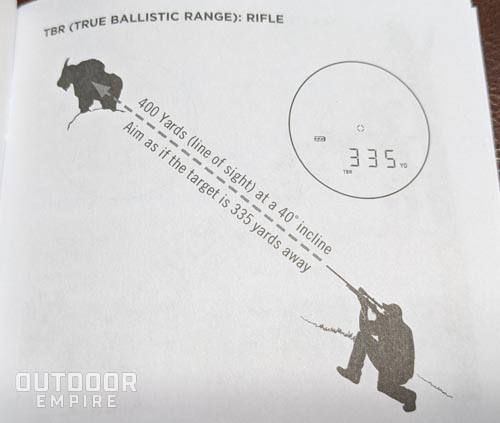
Leupold’s True Ballistic Range and Wind (TBR/W) features also make this a great companion to a long-range shooter. While it does not connect to an external app or allow custom settings, it has a pre-configured library of 25 load groups that closely match most mainstream calibers. The level fire aim adjustments are directly displayed in the display and are relatively easy to interpret.
What We Don’t Like
The only thing there really is not to like about the RX-2800 is Leupold’s weak sauce warranty. A meager two-year limited warranty on electro-optics leaves one questioning whether they stand by their product and is enough to break a tie between this and something like the Maven RF.1 or the Vortex Razor HD 4000.
Overall, the Leupold RX-2800 TBR/W is an excellent monocular rangefinder for long-range shooters. Even with a shorter max range to reflective targets, our experience suggests Leupold specs in that regard hold up better than most. After all, this one has a max range to trees of 2400 yds, only 100 yds shy of the Sig KILO5K.
4. Budget Pick
- Outdoor Empire Score: 4.2
- MSRP: $249.99
- Bottom line: Good glass and functionality at a low price
Compare prices at: Bass Pro Shops, Cabela’s
With the Prime 1800 Bushnell managed to introduce a couple of interesting new features despite maintaining a relatively low price point.
What We Like
While the optical quality, effective range, and most other aspects of this unit are just decent, the display is really cool. Most of the best rangefinders for long-range shooters have red OLED displays that are great in low light, whereas lower-tier rangefinders have classic black LCD displays that are fine during the day, but terrible in low light.
Unlike its little brothers the 1300 and 1700, the Bushnell Prime 1800 has the new ACTIVSYNC display that automatically changes from black in bright conditions to red in low light. It’s a unique feature, especially at this price point.
We also like that it has a tripod mount, angle compensation, different rifle, and bow modes, as well as two different target priority modes, which puts it on a similar playing field as more expensive units.
What We Don’t Like
The Prime 1800 has had some reported reliability and quality issues based on user reviews. Bushnell claims a lifetime “ironclad” warranty, but the fine print says that only means 5 years for electro-optics. We also find that this unit is not quite as reliable at achieving its max advertised range, which puts it on the low end of distance capabilities for long-range shooting.
But still, at less than $250, the Bushnell Prime 1800 can do a lot of the things pricier units do for a long-range shooter, which makes it our budget pick.
5. Best of the Rest
- Outdoor Empire Score: 4.2
- MSRP: $729.99
- Bottom line: Proven and trusted by users
Compare prices at: Optics Planet, Bass Pro Shops, Cabela’s, Sportsman’s Guide
Vortex was perhaps the first optics company to offer an unlimited lifetime warranty, and the fact that they honor that for optics with electronics inside is icing on the cake. The Vortex Razor HD 4000 is a popular rangefinder among long-range shooters, and it’s a safe bet.
What We Like
The ergonomics, buttons on top, belt clip, and ruggedness of the Razor HD 4000 are all things we love about it. We also really like its ELR mode (extra long-range).
Overall it’s a reliable unit with a great reputation and guarantee.
What We Don’t Like
This unit has been available for a while now, and while it is still a great option, the alternatives have surpassed it in terms of technology and features.
Of the units we evaluated, the Vortex Razor HD 4000 was one of the slowest to acquire a distance. And the effective range is less consistent and generally shorter than the top three in our list.
It lacks any special ballistics functionality besides angle compensation, so long-range shooters will either need to do the math on their own or use an app.
However, despite having a higher MSRP, you can usually find it at retailers for a lot less, so it’s still a great buy.
Worthy Alternatives
While the following long-range rangefinders didn’t make our top pick list, they are certainly worthy of mention. Based on our research and having handled tried some of them in the store, we felt these fit the category and could serve a long-range shooter well.
| Product | Outdoor Empire Score (out of 5) | MSRP | Why It Didn’t Make the Cut |
| Leupold RX-1600i TBR/W | 4.5 | $399.99 | Excellent rangefinder for the price, but shorter max range compared to top contenders. |
| Vortex Ranger 1800 | 4.3 | $499.99 | Great warranty and build quality, but lags behind price competitors in measurement speed, effective range, and features. |
| Leica Rangemaster 3500.COM | 4.3 | $1,249.00 | High tech, high quality, but an even higher price compared to our top 3 picks that are just as good or better. |
| Sig Sauer KILO1600BDX | 4.2 | $354.99 | Feels good, shoots fast and priced well, but it’s stuck in the middle in every way. |
| Bushnell Prime 1700 | 3.8 | $209.99 | Decent glass, but mixed reviews on reliability and limited range. |
| ATN Laser Ballistics 1500 | 3.5 | $349.00 | Reasonable price with a fancy app, but has a black LCD display and the build quality is weak comparatively. |
| Cabela’s Intensity 1600R | 2.8 | $179.99 | Low-price leader, but feels cheap, can’t rely on it to range beyond 1000 yds, and has reliability issues. |
Why You Should Trust Us
Chase Fly used to work professionally in the mapping, land surveying, and professional measurement industry. Whether it was helping DOT guys measure stockpile volumes or electric company crews measure spans of powerlines, Chase trained a lot of people on how to use laser rangefinders in real-world applications.
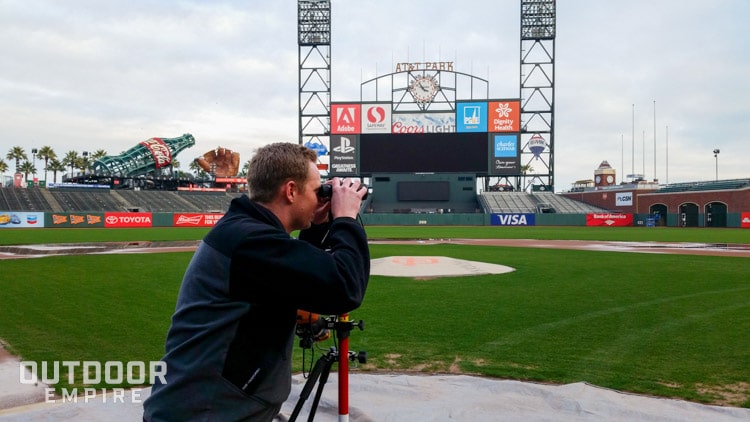
Suffice it to say, he knows quite a bit about the technology and is pretty picky when it comes to rangefinder performance. His background enabled us to filter out a lot of the low-lying contenders during our research phase and to later evaluate and select the top performing devices for our list of best rangefinders for long-range shooting.
In preparation for this review, we researched dozens of rangefinders, then parsed out the ones that would qualify for long-range distance measuring (over 1500 yards). We evaluated and scored the 12 units listed above, and we tried many of them either in the store or in the field. We also interviewed experts at the optics counters of both Sportsman’s Warehouse and Cabela’s. From this, we learned from their personal experience and preferences, got an idea of customer feedback, listened to their recommendations, and gathered golden nuggets of insight.
Important Choosing Factors and Analysis
We based our recommendations above based on a combination of specifications, hands-on experience, and a score we gave to each rangefinder we evaluated. The Outdoor Empire score, compared against the product’s price point and alternatives, is how we ranked the products as we did.
The main decision-making factors that we used to score each product were: optics quality, display, form factor, durability, features, and value. We calculated a composite score out of five points for every rangefinder we reviewed.
Distance Considerations
Long-range is a term that’s different for everyone. It is relative to what the person is trying to do. For example:
- long-range hunting for medium animals starts at 300 yards
- long-range for 50 BMG competition shooters is more than a mile
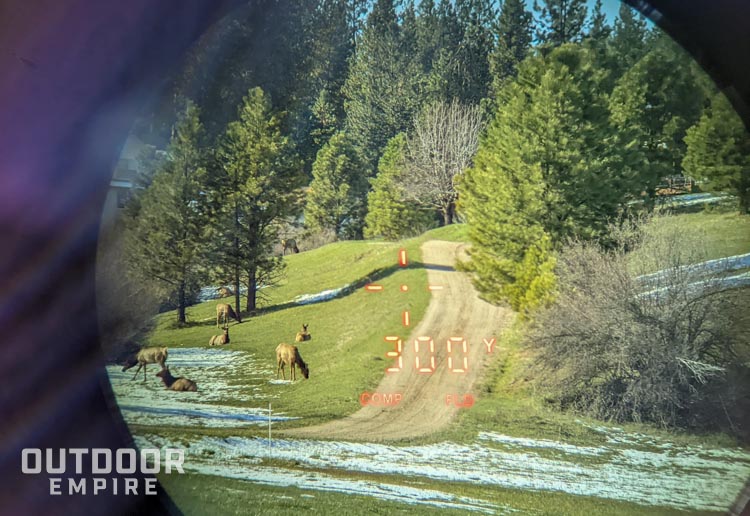
Without a solid foundation as a shooter, it doesn’t matter that your 338 Lapua can reach 1000 yards if you can’t hit the target. So 1000 yards and beyond is almost universally accepted as long-range distance for shooters.
So when choosing a long-range rangefinder, you have to make sure it can reach out to at least 1000 yards with an accurate reading. If it can go a bit beyond 1000 yards, that’s even better.
The price difference between a 1000-yard rangefinder and a 1500 to 1600-yard rangefinder isn’t typically substantial. Being able to reach beyond a thousand yards accurately could be invaluable once you master that 1000-yard space.
We only considered rangefinders for this review that have a specified max range of at least 1500 yards. Though there are many excellent options that are not rated for that, given the advancements in technology over the past few years, this seemed to be a sensible cutoff for 2022 and beyond.
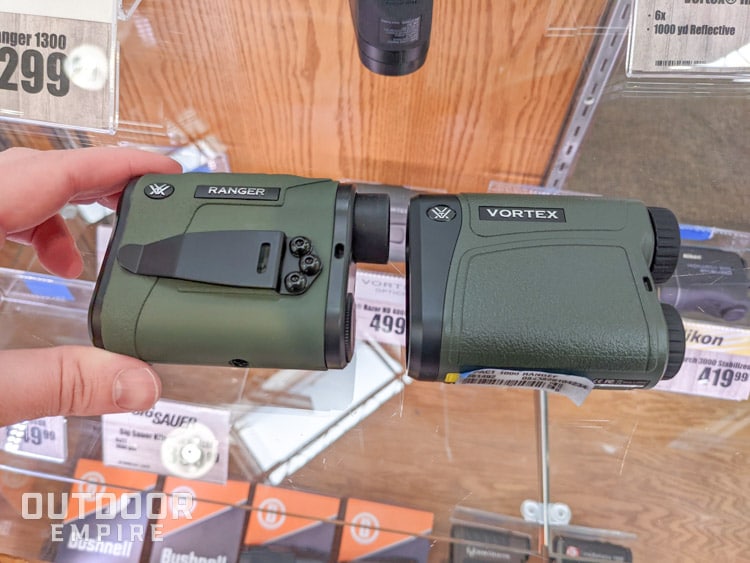
Of all the rangefinders we tested, the Sig KILO5K has the longest specified range at 5000 yards, but the Maven RF.1 performs just as well in the real world. The Maven’s specs for soft targets and trees are slightly better than the Sig, but they both seem to hit semi-reflective hillsides at over 3000 yards without too much issue.
The Leupold RX-2800’s specs are not as sexy, but they appear to be the most realistic of all of them. Meanwhile, the Vortex Razor HD 4000 struggles the most to stretch its legs.
All of our top five picks will reliably range over 1000 yards in nearly any condition, and even well beyond that. They’ll all be more than adequate for long-range shooting.
Accuracy
The further you attempt to target at a distance, the greater accuracy you need.
A small inaccuracy at 100 yards isn’t a big deal at all. You can still hit your target. However, a slight inaccuracy at 1000 yards may result in a complete miss.
This means you should purchase a high-quality laser rangefinder from a reputable brand. It’s critical you search for unbiased reviews to give you a solid understanding of just how accurate it is.
You also want to make sure it’s easy to use, and you understand how to get an accurate reading from it.
Most rangefinders have slight variances between their accuracy ratings so it is not guaranteed to be spot on. They typically have a small inaccuracy, usually less than half a yard of variance.
Of our top picks, the Maven RF.1 touts the best accuracy and our experience confirms the specs, at least for close range. The Bushnell reportedly gets one-yard accuracy at any distance, but some user reviews suggest otherwise. See the table below for the manufacturer specified accuracies.
| Accuracy (+/-) | 0.5 yd | 1 yd | 2 yd | 3 yd |
| Maven RF.1 | < 300 yds | 300-2000 yds | – | > 2000 yds |
| Vortex Razor HD 4000 | < 200 yds | 200-1000 yds | > 1000 yds | – |
| Leupold RX-2800 TBR/W | < 125 yds | – | 125-1000 yds | – |
| Sig Sauer KILO5K | – | 0-500 yds | 500-3000 yds | – |
| Bushnell Prime 1800 | – | 0-1800 yds | – | – |
Optics Quality
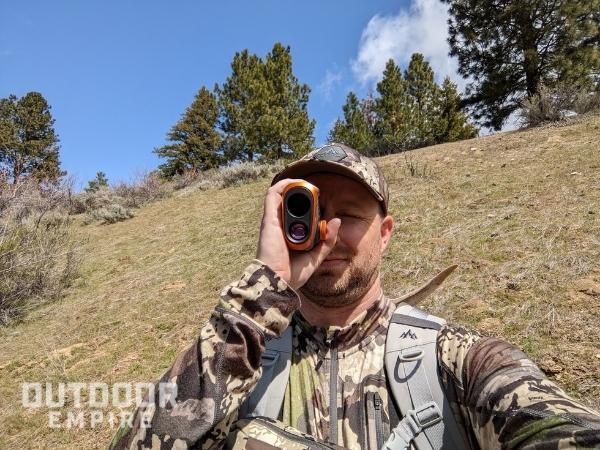
Optics quality can be subjective. There are lots of factors involved like objective lens size, glass quality, clarity, coatings, color, and above all, light transmission.
Every manufacturer has its own methods, often proprietary, of enhancing optical quality. Most reputable brands like Leupold, Vortex, Maven, and Leica have very good glass in their rangefinders that cost over $300.
In our analysis, we not only looked at the specs of the optics but scored them based on our own assessment of how well you can see through them, especially in low light.
Our high scorers for optical quality were the Leupold RX-2800, the Sig KILO5K, the Maven RF.1, the Leica Rangemaster 3500.COM, and the Vortex Razor HD 4000. Meanwhile, the low scorers were the Cabela’s Intensity 1600 and the ATN Laser Ballistics 1500.
Magnification
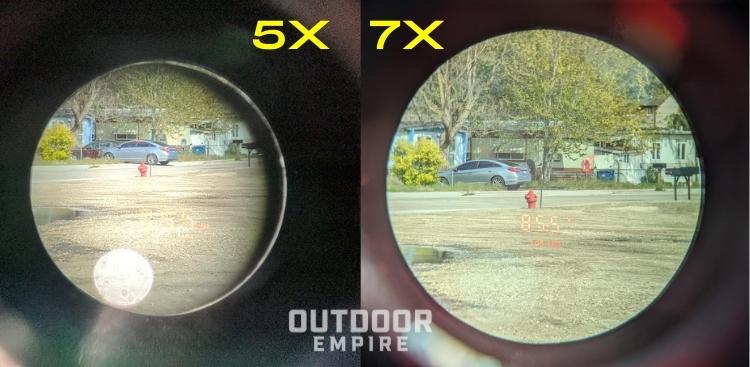
Magnification is a fine balance to walk with long-range rangefinders. If you can’t get a solid picture of your target, how exactly are you going to range it?
You need enough power to see it well so you can utilize the rangefinder accurately. At the same time, too much magnification makes it insanely difficult to find and stay on target. It doesn’t only magnify your target, but also magnifies every breath, shiver and shake you make.
If you ever tried to use a spotting scope without a tripod (see how to choose a tripod), you know what I mean. Too much magnification is a bad thing. It also means the system is bigger and requires a larger objective lens.
In our experience and in keeping with the 1000-yard range theme, 7x is the sweet spot for long-range rangefinders. You can still hone in on close-range targets as well as those farther out. It’s also a good balance that keeps the device small and lightweight. 6x is a bit tight and something like 10x is not only rare to find in a rangefinder, but it is only useful for long-range while being difficult to use close up.
Half of the units we evaluated had 7x magnification, which is very common for this class of rangefinder, while the other half had 6x. Of the top 5, only our budget pick, the Bushnell Prime 1800, had 6x. Other hunting rangefinders we tested with 5x magnification were sufficient for hunting but too little for routing long-range use.
Display
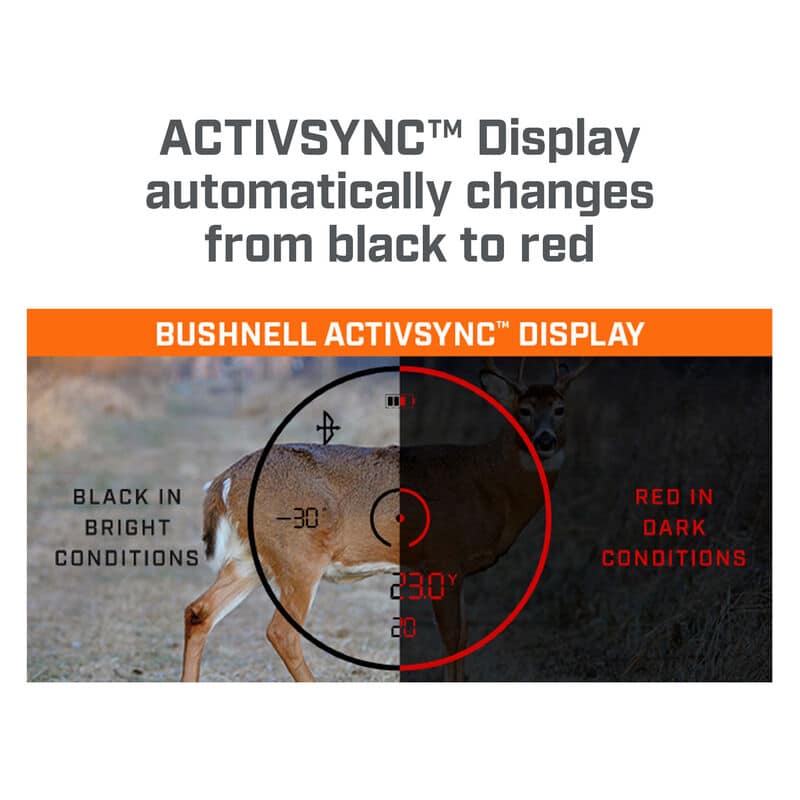
A long-range rangefinder display should be:
- easy to read in low light,
- easy to interpret,
- and easy to navigate through the settings menu.
Bonus points may be awarded for special long-range shooting features like ballistics readouts or reticles. However, too much of that in the little real estate available in a rangefinder’s display can be a detriment to its utility.
All of our top picks faired very well here with our favorite displays being the Maven RF.1, the Leica, and the new display on the Bushnell Prime 1800 that turns from black to red according to the light conditions.
Old school black LCD displays are difficult, if not impossible, to see in low light and are usually only found on cheaper units these days. The Bushnell Prime 1700, Sig KILO1600, and ATN units had black displays. The rest of the units had red LED displays.
Form Factor
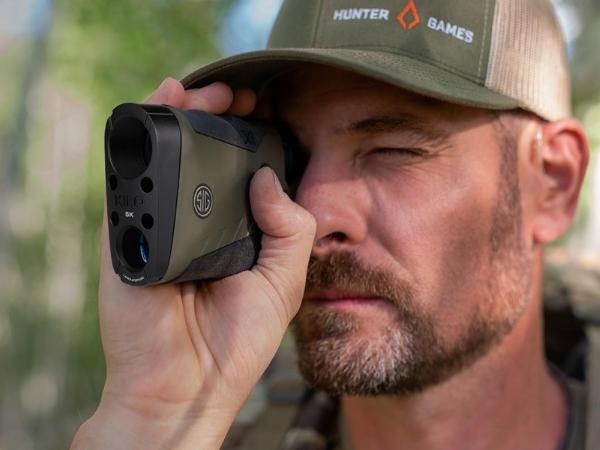
Size and weight are major considerations depending on what you are planning to do with the rangefinder.
- If you are a simple bench rest competition shooter, size and weight don’t necessarily matter. You won’t be lugging that bad boy around much.
- For a hunter or tactical user like a sniper, size and weight is a much bigger issue.
A sniper needs a compact but powerful rangefinder that can easily be packed away when on a mission. They also need to maintain a low profile as much as possible. In a hide, they don’t want a large machine to wave around. Slim, lightweight, and compact is a big deal for the gear that these guys use.
The most compact units we looked at included the Leupolds and the Vortex Ranger 1800 with the Sigs and the Leica coming in moderately slim. The Maven RF.1 and Vortex Razor HD 4000 were probably the heaviest (approx. 10 oz) and bulkiest compared to the rest. The Cabela’s and ATN are also rather bulky, though a bit lighter since they are made of cheaper materials. They all fit in the hand nicely.
Durability
Long-range rangefinders are made from various materials, some fragile and some rugged. Think about it. They have electronics, magnified glass lenses, and laser emitters. None of these are known for their durability. So the housing needs to be tough around those fragile materials.
The overall body strength of the device should also be durable. On top of this, you want it to be sealed against moisture and debris. You don’t need to dive at the bottom of the ocean with a rangefinder but you want it to resist some morning dew at least.
You have to remember, it’s a lot like binoculars and rifle scopes due to the use of optics. So you also want it to be fog proof and preferably nitrogen or argon purged.
Of the units we tested, the Maven RF.1 is the only one built to IP67 standards, meaning it can withstand multiple drops onto a hard surface from 1m above the ground and can be submerged 1m underwater for up to 30 minutes and still function.
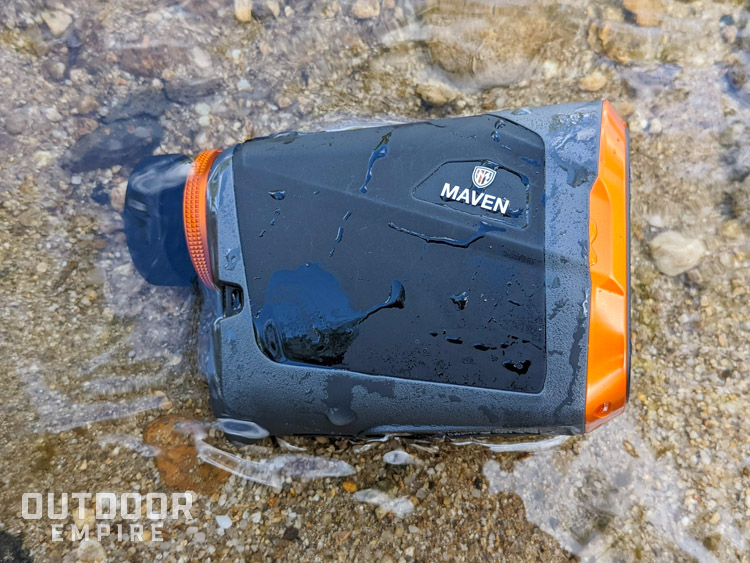
Most of the rangefinders we tested were advertised to be at least water-resistant, if not waterproof, and had coated lenses to resist moisture buildup in the fog or rain. But few addressed shock.
The toughest housings were made of stronger polymer materials with a magnesium or aluminum chassis like the Maven, Leupolds, and Sig Sauers on our list. But the Cabela’s, ATN, and Bushnell units were more plasticy and felt less rugged.
Features
The right long-range laser rangefinder will not only tell you the distance to the target, but it will give you level fire range (a.k.a. true ballistic range) by doing a calculation that takes into account any elevation change between you and the target. Some call it angle compensation. All the rangefinders we considered for this list did this.
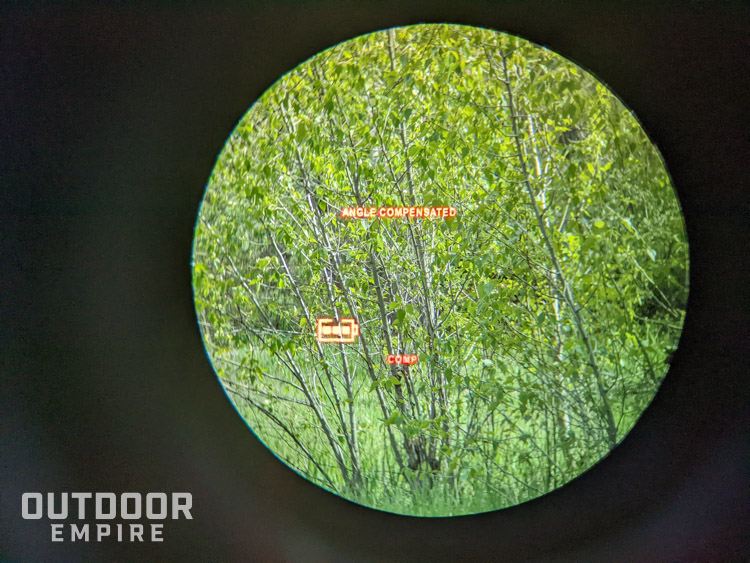
Fancy Ballistics Calculations
Leupold has its TBR/W (True Ballistics Range and Wind) feature set which not only figures in angle compensation but also adjustments for specific loads and cartridges. You can then have the rangefinder display the distance to aim for along with the holdover in inches, milliradians, or MOA. So you have everything you need to dial in the turrets on your scope for an accurate shot.
For more details on how the Leupold TBR/W features work, check out our review on the Leupold RX-1400i TBR/W.
The Sig Sauer rangefinders we looked at support Sig’s BDX (Ballistics Data Exchange) functions including Bluetooth connectivity with a smartphone and the Sig app, or even compatible BDX rifle scopes. Beware that they do limit the effective range of the BDX features in the software of these devices, which is why the KILO1600BDX is only useful out to 800 yards with BDX.
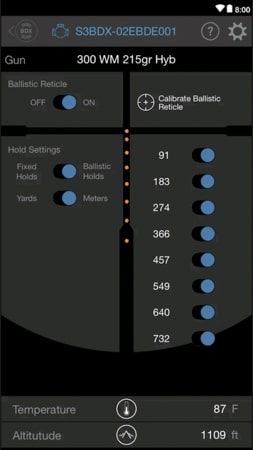
Similarly, Leica’s Rangemaster 3500.COM connects to a smart device, even an Apple Watch, to give you those calculations.
Once you go through the motions, these features are not too difficult to figure out and understand. But they do all have their limitations and won’t work for every gun, cartridge, load, environment, and shooter.
Frankly, if you already use a ballistics app or are an avid shooter that can (or likes to) do these calculations yourself, these features are not a must-have. Solid core functionality, like what you find in the Maven and Vortex rangefinders, is sufficient for most.
Tripod Mount
One simple, mechanical feature that is extremely useful to long-range shooters is tripod mounting capabilities. This gives you the option to mount the rangefinder on a tripod for steady distance ranging.
Even on our favorite units that range well beyond 1500 yards, it is often difficult to hold them steady enough to get a return on a distant hillside, let alone a small target. A tripod mount can resolve that problem.
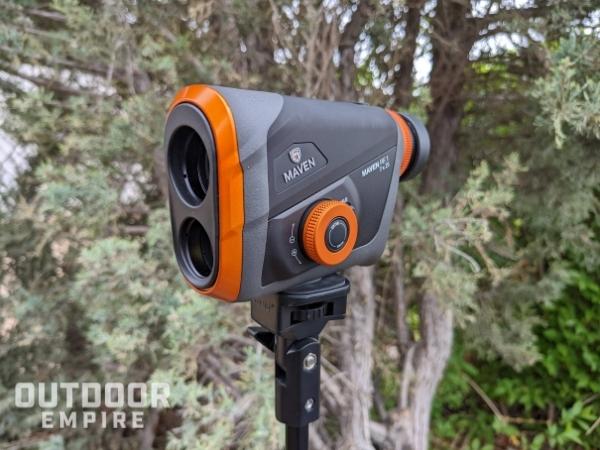
Of the units we tested, the following have a standard ¼” x 20 female threaded tripod mount, while the rest have nothing of the sort:
- Maven RF.1
- Leupold RX-2800 TBR/W
- Vortex Ranger 1800
- Bushnell Prime 1800
- Vortex Razor HD 4000
Value
The most valuable long-range rangefinder is not necessarily the most nor the least expensive. It’s the one that gives you the greatest cost-benefit, or essentially the most features, quality, and functionality for the lowest price compared to similarly priced products.
This is where the Maven RF.1 stands out the most, in our opinion. It’s not the cheapest, but it’s less expensive than the others with similar functionality and quality. We also think the Leupolds and the Sig Sauers offer great value, with the Vortexes coming up behind them.
The Bushnells offer decent value given their price, but the Cabela’s and ATN are about as good as you might expect for the cheaper price point. They don’t particularly stand out in any way.
The Leica offers the least amount of value. Not because it’s a bad machine, in fact, it’s one of the best. But it is so dadgum expensive that it’s hard to justify paying that much when others on this list do just as much or more for way less money.
Warranty
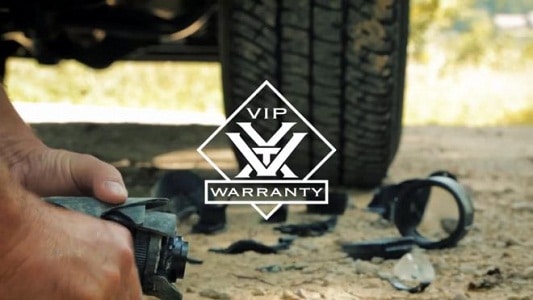
A good warranty is a must-have on a rangefinder designed for long-range. It ensures that if you have an issue with the product, you aren’t out your initial investment. No questions asked lifetime warranties are great, but only Maven and Vortex offer it for rangefinders.
Likely, a good warranty covers and guarantees the electronics and quality for at least five years. This applies to Bushnell and Sig Sauer.
Leupold offers some of our favorite long-range rangefinders, but unfortunately, they have the weakest limited warranty of all at only two years.
Recommendation
Rangefinders fail for a variety of reasons, all of which tend to be amplified the farther away you are. Some rangefinders are simply not designed to be used at a long distance.
When it comes to long-range shooting, even though there are rangefinders for less than $100, it’s worth spending at least a few hundred bucks to get a mid-grade or premium long-range rangefinder. Save up a little longer if you have to so you can get a good one that may even last a lifetime.
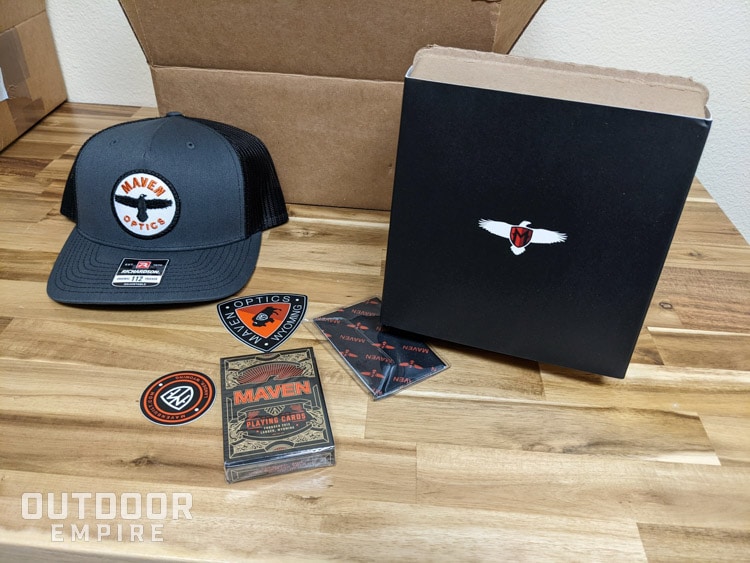
The Maven RF.1 is a great option that we recommend to any serious long-range shooter. It’s fast, easy to use, and super durable.
If you like all the bells and whistles, get the Sig KILO5K.
If you want a multi-purpose (hunting and shooting), semi-long range performer that won’t break the bank, the Leupold RX-1600i TBR/W would be our pick out of all of these.
But if you are really only going to use a rangefinder for hunting, you probably don’t need to spend quite as much for extended max range and fancy features. In that case, learn more about rangefinders, how they work, and what products we recommend for other use cases in our comprehensive hunting rangefinder buying guide.
Related:
Rangefinder Reflective Vs Non-Reflective Target Range Explained!

